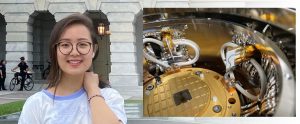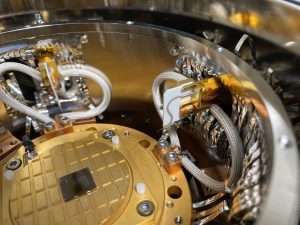
About Baiyu: My name is Baiyu Zhang and I’m a 2nd-year Ph.D. student from the department of Electrical and Computer Engineering at Duke University under advisement from Professor Aaron Franklin. My research focuses on high-performance field-effect transistors using two-dimensional nanomaterials. Using nanomaterials to replace silicon as transistor channel material has shown a lot of promise, but progress is still limited by challenges related to the fabrication, performance, and reproducibility of devices. My current project studies the influence of different transistor geometries on the ultimate performance of the devices, including an effect know as contact scaling. During my free time, I enjoy reading, traveling, hiking, and cooking. I also like learning different languages and am often thrilled to find out the correlation between languages and cultures.

Testing a finished device using vacuum probe station in Franklin Lab.
What RTNN facilities or instruments are you using in your research, and how do they help you? I spend the majority of my lab time in the Shared Materials Instrumentation Facility (SMiF) at Duke. For fabricating nanoscale devices in my projects, I use electron-beam lithography, electron-beam evaporation, atomic layer deposition, reactive ion etching and so forth. Then I also use various analytical tools such as scanning electron microscopy, atomic force microscopy, and Raman spectroscopy.
.
What about your research makes you excited about its impact? Transistors are the heart of all computing technology, so advancements in transistors can push forward virtually all areas of science and technology. Having the opportunity to study in such a pivotal field is simply an exciting privilege.
What is your favorite thing about using RTNN facilities? SMiF staff members at Duke are exceptional. Everyone is so kind and responsible. They are always helping us with their knowledge and endless patience. Their help has made our research work in SMiF feasible and efficient.

